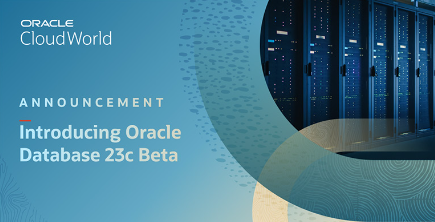【学习】
2025年阅读清单
-
Oracle 23c New features - Data Quality Operators in Oracle Database Tips
Oracle 23c New features - Data Quality Operators in Oracle Database Tips

Oracle Database 23c introduces the following two new string matching operators based on approximate or “fuzzy” string matching.
PHONIC_ENCODEconverts words or phrases into language-specific codes based on pronunciation.FUZZY_MATCH, which is language-neutral, gauges the textual similarity between two strings.
The new phonic encoding and fuzzy matching methods enable more sophisticated matching algorithms to be run directly on data in the database rather than only in external applications, providing improved matching performance and efficiency, for example in data de-duplication, linking or enhancement
-
Oracle ADB export data to Other Database Tips
Oracle ADB export data to Other Database Tips
-
Oracle 23c export table data to csv via sql Tips
Oracle 23c export table data to csv via sql Tips

-
Oracle 23c New features - Real-Time SQL Monitoring Enhancements Tips
Oracle 23c New features - Real-Time SQL Monitoring Enhancements Tips

Real-time SQL Monitoring works independently and concurrently across multiple PDB containers in an efficient manner. SQL statements, PL/SQL procedures and functions, and DBOPs (Database Operations) are monitored at PDB and CDB levels. You can efficiently query SQL Monitor reports across ad-hoc time ranges, DBIDs (internal database identifiers), and CON_DBIDs (CDB identifiers). This data is also accessible through SQL History Reporting.
Additionally, SQL Monitoring data can be exported along with the Automatic Workload Repository (AWR) and imported into another database or container for longer term storage and analysis.
Real-time SQL Monitoring is now supported per-PDB and CDB levels efficiently by default. As a PDBA persona, you can get a more accurate view of the monitored SQL for your application.
SQL Monitoring data can be transported through the AWR framework to a different container or database for longer term storage and offline analysis.
-
Oracle 23c New features - Automatic Parallel Direct Path Load Using SQL*Loader Tips
Oracle 23c New features - Automatic Parallel Direct Path Load Using SQL*Loader Tips

The SQLLoader client can automatically start a parallel direct path load for data without dividing the data into separate files and starting multiple SQLLoader clients. This feature prevents fragmentation into many small data extents. The data doesn’t need to be resident on the database server. Cloud users can employ this feature to load data in parallel without having to move data on to the cloud system if there is sufficient network bandwidth.
SQL*Loader can load data faster and easier into Oracle Database with automatic parallelism and more efficient data storage.
-
Oracle 23c New features - Evolution of Oracle Homes Tips
Oracle 23c New features - Evolution of Oracle Homes Tips

Oracle base home, Oracle base config, and orabasetab.
-
Oracle 23c New features - Control PDB Open Order Enhancements Tips
Oracle 23c New features - Control PDB Open Order Tips

Control PDB Open Order
To Set the Priority of a PDB
Use the ALTER PLUGGABLE DATABASE <databasename> Priority <value> set the priority.
-
Oracle 23c create user values Tips
Oracle 23c create user values Tips
-
Oracle 23c New features - Encryption of Tablespaces in an Oracle Data Guard Tips
Oracle 23c New features - sql_transpiler Tips

About the Encryption of Tablespaces in an Oracle Data Guard Environment
-
Oracle 23c New features - DBCA Support for Standard Edition High Availability Tips
Oracle 23c New features - sql_transpiler Tips

Oracle DBCA Support for Standard Edition High Availability
Using the Oracle Database Configuration Assistant (Oracle DBCA) and facilitating Oracle’s Automatic Storage Management or Oracle’s Advanced Cluster File System, you can now quickly create a Standard Edition High Availability Oracle Database fully configured for automatic failover.
Oracle Standard Edition High Availability Database can now be created very easily with more automation, eliminating manual steps and the associated complexity.
-
MacOS restart ssh Tips
MacOS restart ssh Tips
% sudo launchctl list | grep ssh % sudo launchctl load -w /System/Library/LaunchDaemons/ssh.plist % sudo launchctl list | grep ssh - 0 com.openssh.sshd % sudo launchctl unload /System/Library/LaunchDaemons/ssh.plist % sudo launchctl list | grep ssh % sudo launchctl load -w /System/Library/LaunchDaemons/ssh.plist % sudo launchctl list | grep ssh - 0 com.openssh.sshd % sudo systemsetup -getremotelogin Remote Login: On %
-
Oracle 23c Store AWR Snapshots In User Defined Tablespace Tips
Oracle 23c Store AWR Snapshots In User Defined Tablespace Tips

The AWR warehouse is built in the SYS schema, using the SYSAUX tablespace by default. Oracle Database, by default captures snapshots once every hour; the snapshot size varies depending on the database load. These snapshots will be stored in SYSAUX tablespace.
Starting with Oracle Database 19.1c, the user can specify a user defined tablespace for AWR data/snapshots by using the ‘dbms_workload_repository.modify_snapshot_settings’ procedure, using ‘tablespace_name’ parameter.
- Oracle 26ai release from 2025/10/15 Tips
- Oracle redo generation's causes Tips
- Oracle 23ai Cell events Tips
- Linux firewall-cmd Tips
- AI SQL Tips
- Dify Chat Bot test Tips
- Oracle 23ai BaseDB 23.6 to 23.7 Tips
- Oracle 23ai and Ollama REST api Tips
- Deepseek Free Tips
- Oracle 23ai RAG Third-Party Provider Operations and Endpoints Tips